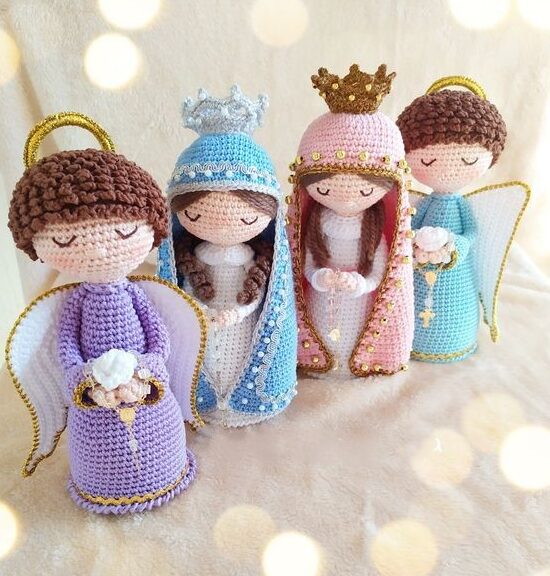Amigurumi, a Japanese crochet technique for creating three-dimensional dolls and objects, offers a unique opportunity to express our faith and religious devotion.
In this article, we’ll explore creative ideas for making saint and angel amigurumis, which can become special pieces of decor, meaningful gifts or religious souvenirs.
Let’s find some inspiring suggestions for you to put your crochet skills to work and bring these spiritual figures to life.

-
Miniature saints:
A charming idea is to create amigurumis out of miniature saints. Choose the saints you want to represent, such as San Francisco de Assis, Santa Terezinha do Menino Jesus or Santo Antônio, for example. Use cotton threads in the corresponding colors and create a simple design that represents the figure of the saint, such as the tunic and the characteristic details. These little amigurumis can be hung on a religious wall, a Christmas tree or even a rosary.
2. Protective Angels:
Angels are spiritual figures often associated with divine protection and guidance. You can create protective angel amigurumis to give to friends or family on special occasions, such as baptisms, first communions or religious weddings. Use white threads or muted colors to represent the purity and peace associated with angels. Add cute wings and a delicate face to bring your amigurumi to life. These little angels can be placed on shelves, bedside tables or even in a special prayer corner.
3. Amigurumis with built-in prayers:
How about creating amigurumis that also have a built-in prayer? This is an original idea to unite the devotion and practice of crochet. For example, you can make an amigurumi of a picture card with a small pouch or pocket on the front where a specific prayer can be inserted. Choose popular prayers such as the Our Father, Hail Mary or a prayer of your own personal devotions. These amigurumis with embedded prayers can be held while praying or can serve as meaningful religious keepsakes.
4. Guardian angel amigurumis:
Guardian angels are considered spiritual guides and protectors in many religious traditions. Creating amigurumis of these angels can be a lovely way to remember the divine presence and care in our lives. Use white yarn or muted tones for the body and wings, and add details like delicate hair and face. These amigurumis can be placed in cribs, bedside tables or in a special prayer area. You can also personalize these amigurumis by adding symbolic elements, such as a ribbon with the name of the person for whom the guardian angel is intended, or a small religious medal.
5. Amigurumis of patron saints:
Create amigurumis of the patron saints of loved ones. Research the saints associated with individual names or interests and use threads in the corresponding colors to represent them. For example, if the person is devoted to Saint Joseph, you can make an amigurumi with a brown tunic and gold details. Add characteristic symbols, such as a flower for Santa Rosa de Lima or a heart for Valentine’s Day. These personalized amigurumis will make meaningful and inspirational gifts.
6. Religious backdrops in amigurumi:
Go beyond individual amigurumis and create complete religious scenarios. For example, you can make an amigurumi nativity scene, with traditional Christmas characters such as Mary, Joseph, Baby Jesus, the Magi and animals. Use your creativity to bring these crochet characters to life by adding details like clothing and accessories. Another idea is to create a scene of the last supper, with Jesus and the apostles. These religious amigurumi backdrops can become standout pieces in your religious decor.
Conclusion:
Making amigurumis of saints and angels is a unique and creative way to express faith and religious devotion through crochet.
The ideas mentioned above are just a few suggestions to inspire you to create special and meaningful pieces. Remember to choose suitable patterns or create your own designs, using quality yarn and paying attention to detail.
May these religious amigurumis bring spiritual comfort, inspiration, and be treasured keepsakes for you and those who receive them.









